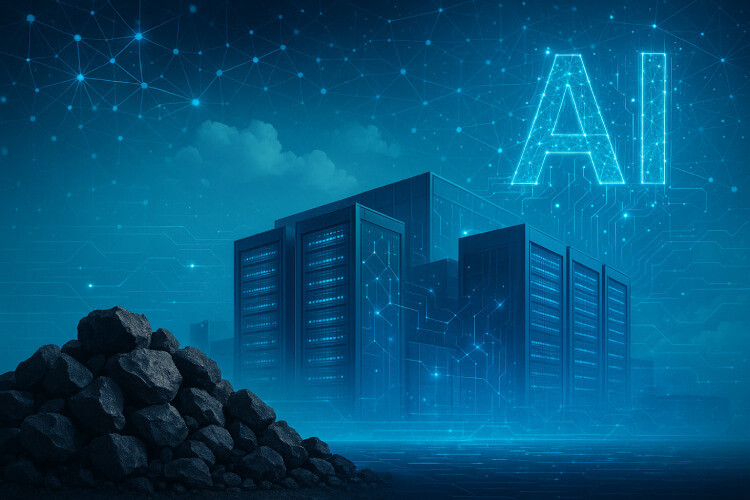Trump Coal Data Centers Plan Raises Power Grid Debate
Insights | 06-06-2025 | By Robin Mitchell

Key Takeaways:
- AI and cloud computing are driving record-breaking power demands — Modern datacentres are consuming energy at unprecedented rates as workloads shift toward artificial intelligence and high-resolution media.
- Policy shifts are putting coal back on the map — A recent executive order reclassifies coal as a strategic resource, fast-tracking its role in powering AI data hubs despite environmental concerns.
- Industry remains divided over energy strategy — While some tech giants acknowledge the need for fossil fuels, most are leaning toward natural gas and renewables over coal to meet climate targets.
- Infrastructure constraints complicate transition to clean energy — Grid reliability, regulation, and rollout delays are forcing stakeholders to weigh short-term compromises against long-term sustainability.
While cloud computing has revolutionised the digital world, the ever-growing appetite for data has pushed datacentres into the spotlight—not just as enablers of modern life, but as massive energy consumers. From powering AI models to streaming high-definition media, the demand on server infrastructure is ballooning at a pace that’s testing the limits of existing power grids.
What energy challenges do modern datacentres face, why is the industry leaning on legacy fuel sources like coal, and what does this mean for the future of clean, scalable computing?
The Energy Dilemma of Modern Datacenters
Datacenters have consistently been at the heart of modern technology for decades. Whether you are checking your email, streaming a video, or using a cloud-based software tool for work, there is a data center ticking away in the background, making the magic happen. In fact, most of the public are completely unaware that nearly everything they do online is powered by these behind-the-scenes giants.
However, in recent years, there has been a seismic shift in the nature of data demand. The rise of AI, high-frequency trading, 4K streaming, and other computationally hungry applications has taken center stage, turbocharging the demand for processing power. That translates directly into a surge in energy consumption. Not just a gentle uptick but a colossal jump. Some of the latest AI models chew through power at rates that put traditional workloads to shame. If you think your desktop PC draws a lot of juice, imagine a warehouse full of water-cooled GPU clusters working around the clock. It is not pretty when the electrical bill arrives.
AI's Power Hunger Is Redrawing the Energy Map
All of this puts data center operators and power providers in a tight spot. Not only must they keep up with the explosive demand, but they are also under tremendous pressure to go green. Data might be virtual, but the environmental impact is anything but. Cooling racks, spinning disks, and humming processors all contribute to a real-world carbon footprint.
And this is where it gets tricky: data centers can only be as green as the power grid that feeds them. If the local power provider is burning coal and oil, those racks full of the latest silicon are, in effect, digital smog factories. Sure, you can plaster "eco-friendly" banners on your website and claim a reduced footprint by buying some carbon offsets, but the reality is that without clean energy sources, you're only moving the shell around on the chessboard.
Some forward-thinkers are exploring alternative solutions like on-site small-scale nuclear reactors or other renewable installations, but here, too, enthusiasm smacks into the brick wall of government regulation and political red tape. Even if you wanted to roll out a few next-gen modular reactors to cleanly power your datacenter, you'd need a green light from a maze of regulators - most of whom have never set foot in an actual datacenter, let alone understand the technicalities of power provision.
Another angle that often gets ignored is that many modern companies are basically virtual. They have ditched physical offices, swapped paper for pixels, and moved every last operation to the cloud. This means their entire business, from payroll to R&D, runs on the backbone of someone else's data center. Their environmental credentials are now a direct function of their provider's energy mix. If your cloud provider is stuck with dirty power, so are you, regardless of how many remote work policies you implement or how many times you swap to LED lightbulbs at home.
Trump Announces Increase Coal Burning To Meet Demands
President Donald Trump has recently announced plans to revive the struggling coal mining industry in the US by utilising coal-powered plants to meet the growing demand for electricity from data centres. The data centres, which are primarily used to train artificial intelligence systems, have been increasingly dependent on renewable energy sources such as wind and solar, but the increasing demand for AI is putting pressure on the power grid.
In support of this strategy, the Presidential Executive Order outlined coal’s renewed designation as a strategic mineral, opening pathways for expedited leasing and regulatory waivers across Federal lands. This reclassification aims to simplify environmental assessments and fast-track infrastructure that can support the siting of AI data centres in coal-rich regions, particularly where grid stability is a concern.
Tech Industry Faces Trade-Offs in Power Sourcing
As a result, the tech industry is being forced to turn to fossil fuels to meet its power needs. However, instead of focusing on coal, many in the industry are looking to natural gas as a more environmentally friendly alternative. Natural gas produces significantly less CO2 per kilowatt hour than coal, making it a more attractive option for companies looking to reduce their carbon footprint.
Nonetheless, the order explicitly instructs agencies to reconsider and potentially revoke policies that discourage investment in coal-based energy systems. This includes revisiting legacy restrictions imposed on financing, permitting, and environmental compliance, measures which previously steered infrastructure development towards cleaner fuels. As a result, coal may remain in the energy mix longer than many stakeholders had anticipated, particularly where natural gas logistics or regulatory frameworks pose limitations.
Coal's New Role in the AI Infrastructure Playbook
Further complicating the debate is the administration’s push to align coal energy with artificial intelligence infrastructure specifically. Section 10 of the executive directive mandates an interdepartmental assessment of coal-powered facilities that could feasibly support AI data workloads. The goal is to identify regions where such capacity exists and evaluate the feasibility of expansion, underscoring a belief in coal’s reliability for powering always-on, high-performance compute environments. However, no clear consensus has yet emerged from industry leaders on whether these legacy systems align with long-term sustainability goals.
The push to utilise coal-powered plants to meet data centre demands has been met with mixed reactions from the tech industry. While some companies, such as Amazon, have acknowledged that fossil fuels will be needed to meet power demands, they have not committed to using coal. In fact, many tech companies have stated that they are open to using a variety of energy sources, including natural gas and renewables, to meet their power needs.
Are We at an Energy Impasse?
Getting rid of CO2-producing energy sources is an obvious win from an engineering and sustainability perspective. Whether or not you think humans are the main drivers behind climate change, the one inarguable fact is that fossil fuels are a finite resource. Betting society's future on something so exhaustible while ignoring cleaner and more sustainable options is not just shortsighted - it is, frankly, irresponsible.
Even if you shelve the environmental arguments, moving to long-term energy sources just makes sense. Wind and solar, love them or hate them, aren't going anywhere; the sun and wind are a lot more enduring than any coal seam or oil field. Sure, their intermittency is a pain to deal with (as any grid engineer will tell you), but with the right investment in storage and smarter grids, they offer genuine longevity. They may not be perfect solutions today, but they are at least a pathway to keeping the lights on for generations - something you cannot say about fossil fuels running on borrowed time.
Now, if we are being honest, fusion is the perfect solution - the closest thing to flipping the "god mode" switch on humanity's power problems. The trouble is, anybody who has worked in this field will tell you it has been "20 years away" since the 1970s, and that is unlikely to change in the near future. There is no free lunch, and pinning all hopes on a technology that stubbornly refuses to turn the corner is not a viable strategy.
Coal's Industrial Value Beyond Electricity
Another uncomfortable truth is that coal is much more than a fuel. It is a chemical feedstock for steelmaking and countless other industrial processes. You can't run a proper steel foundry or produce certain chemicals without coal, at least with today's tech. That means every ton we burn to keep a data center humming is a ton not available for industries that literally cannot function without it.
Now, what if data center energy needs keep shooting through the roof? When push comes to shove, priorities shift fast. Keeping silicon spinning might become important enough that, even reluctantly, some regions will fire up old coal plants - because, as anyone who has done real engineering knows, you cannot power into existence simply by wishing for renewables to scale overnight. And with nuclear still hamstrung by regulation and slow rollouts, the "best of a bad set of options" can become the only real option.
So yes, we are at an impasse. The ideal path forward is obvious, but practicality forces some uncomfortable compromises - at least in the short term. The only real mistake is pretending otherwise. The trick will be investing in genuine alternatives now, not just talking about them, and making sure the backup plan is not burning our future to keep the present running.

